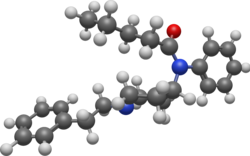 | |
 | |
| Legal status | |
|---|---|
| Legal status |
|
| Identifiers | |
| |
| CAS Number | |
| PubChem CID | |
| ChemSpider | |
| UNII | |
| KEGG | |
| CompTox Dashboard (EPA) | |
| Chemical and physical data | |
| Formula | C24H32N2O |
| Molar mass | 364.533 g·mol−1 |
| 3D model (JSmol) | |
| |
| |
Valerylfentanyl is an opioid analgesic that is an analog of fentanyl and has been sold online as a designer drug. [1] It has been seldom reported on illicit markets and there is little information about it, though it is believed to be less potent than butyrfentanyl but more potent than benzylfentanyl. [2] In one study, it fully substituted for oxycodone and produced antinociception and oxycodone-like discriminative stimulus effects comparable in potency to morphine in mice, [3] but failed to stimulate locomotor activity in mice at doses up to 100 mg/kg. [4]